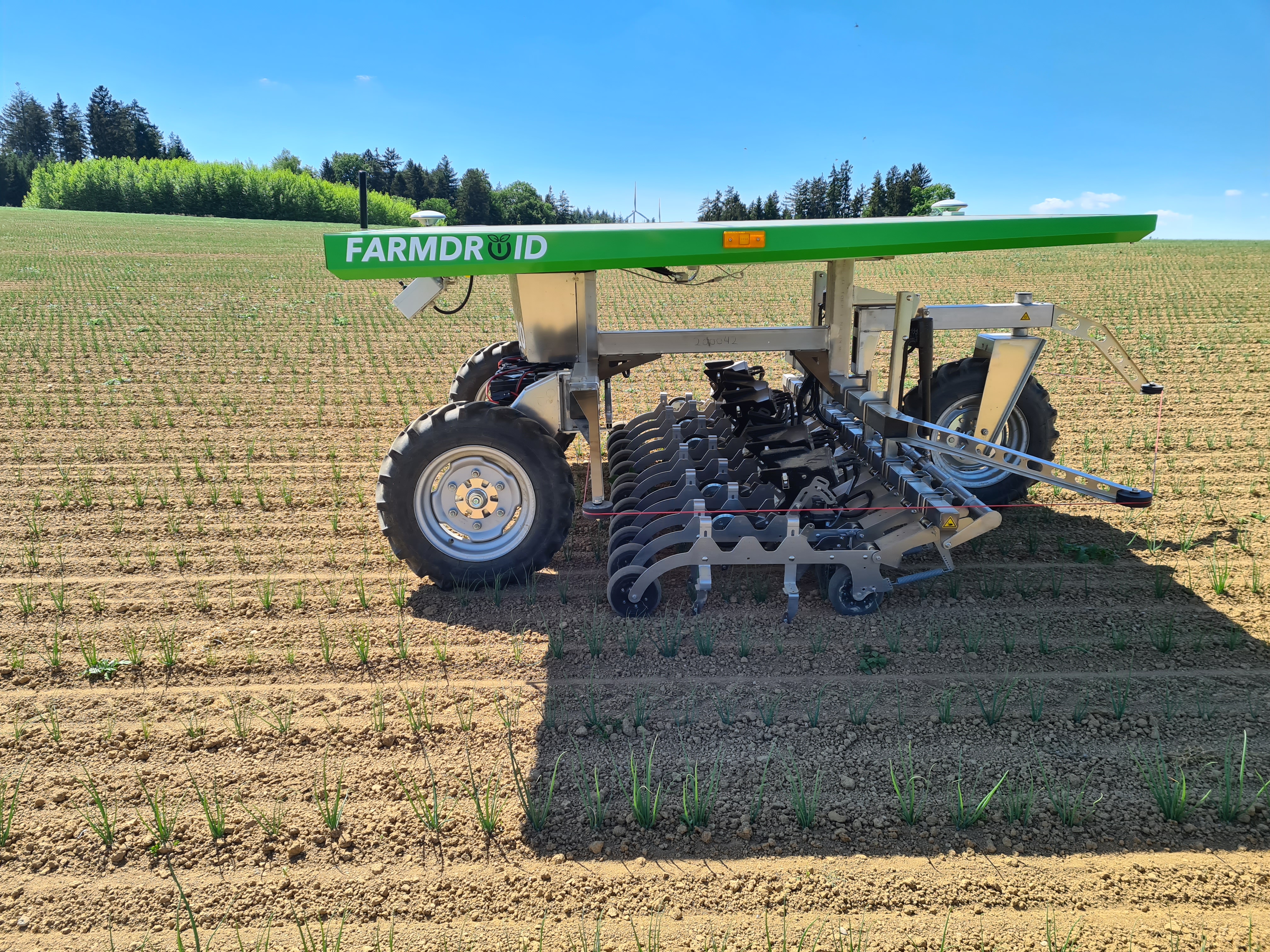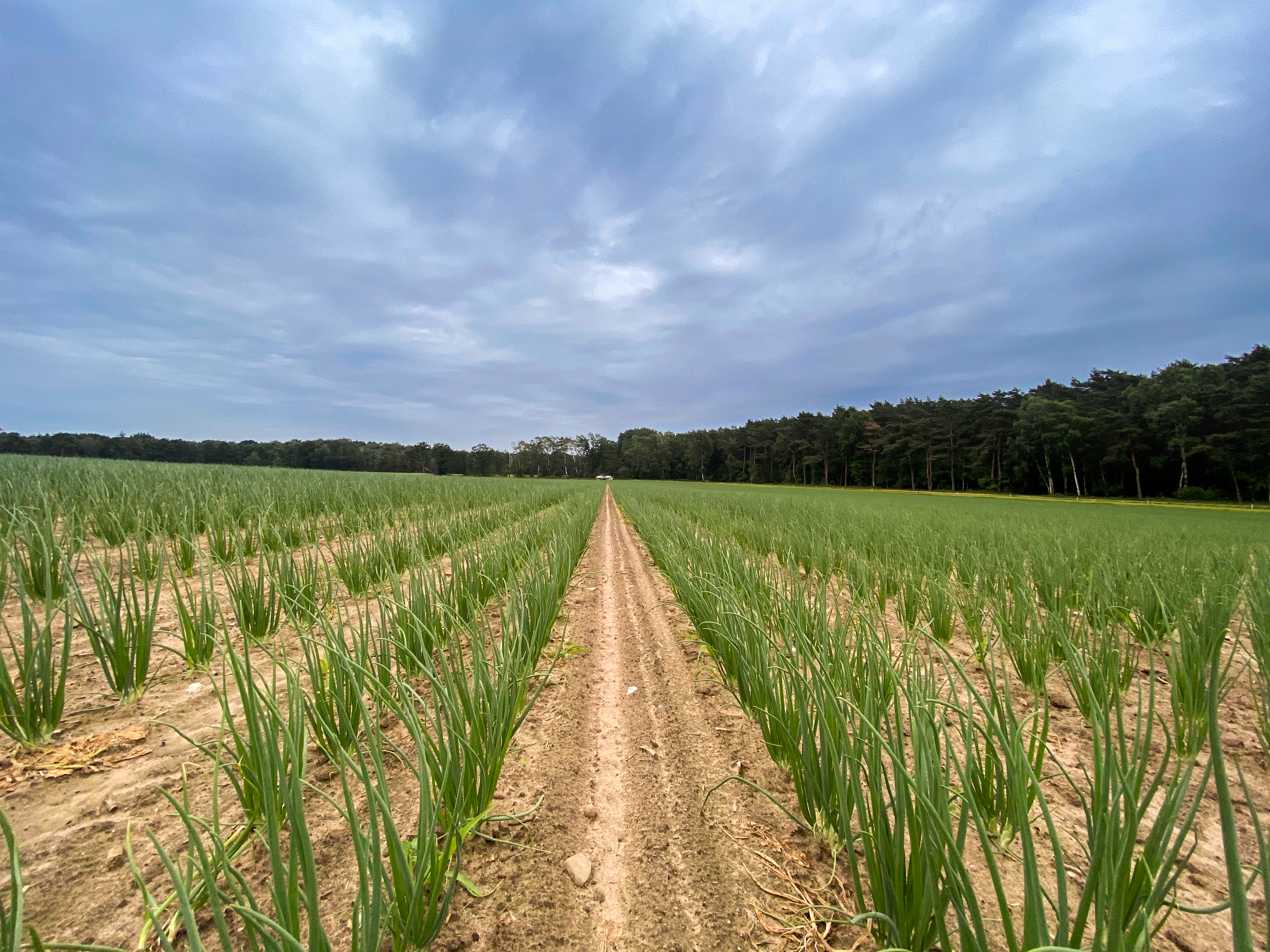ONION (Allium cepa sp.)
Recommendations for cultivating onions and for the use of FarmDroid, to help you shape your own successful recipe!
FD20 removing weeds in an onion field
1. TEMPERATURE AND DAYLIGHT REQUIREMENTS
|
Growth stage and temperature |
°C |
Photoperiod for bulbification |
hours of light |
|
|
Germination |
Seeding period |
|
||
|
Minimum |
1-2 |
Late-summer, autumn |
12 |
|
|
Optimal |
13-28 |
Late winter, early spring |
14 |
|
|
Foliar growth |
Spring |
16 |
||
|
Minimum, lethal |
-8/-11 |
|||
|
Base |
6 |
|||
|
Optimal |
20-27 |
|||
|
Maximum |
30 |
KEY FACTS
- Minimum germination time is generally no less than 1 week. In optimal conditions, 50% of the germination is achieved after 140 degrees-day.
- During germination and the early stages, onion is the most sensible to frost damage
- Photoperiod is a key factor for onion cultivation. In fact, bulbification only starts if photoperiod requirements are met. For this reason, choosing the correct cultivar and seeding period is fundamental:
- If Plants keep producing leaves if daylight hours are not enough. (e.g. long-day varieties sown in autumn or early spring)
- Bulb growth start too early and plants won’t have enough leaves to support high yields (e.g. short-day varieties sown in spring)
In addition, the bulbification stage is reversible, which means that if onions is in the latest growth stages when days are short and temperatures are low, they would start producing leaves again.
2. SOIL REQUIREMENTS
| BEST CONDITIONS | AVOID | |
|
|
It is possible to grow onions in sandy soils as well if pH and water requirements are met.
3. SEED-BED PREPARATION
Onions are normally sown directly in the soil and this requires a fine seed-bed.
There is a range of possibilities when it comes to soil preparation, but generally, there are two main options:
- Classic operations: Plowing or subsoiling, both at 40 cm depth, followed by harrowing to reach the targeted soil consistency
- Short-timeframe operations: cultivator at a depth of 25-35 cm followed by harrowing if the clods are too big. It is possible when there are not too many crop residuals in the field (e.g. following carrots, lettuce)
In case the soil gets too soft, use a non-flat surface roller to prevent the formation of a top-surface crust.
Seed-bed preparation should be done as close as to the seeding date as possible for limey and sandy soils since they are not able to keep stable soil conditions.
4. VARIETIES CLASSIFICATION
There are two different types of seeds that can be bought: standard varieties and hybrids. The latter, having the highest qualitative and quantitative production potential, at a higher seed cost.
Before choosing a variety, each farmer should consider a number of factors:
- Product destination (fresh consumption or industrial processing)
- Market requests (shape, color, dimensions)
- Cultivation environment
- Cultivation period
- Storability
- Storage-life
- Resistance to diseases, with a special focus on Fusarium spp.
5. SEEDING
Direct seeding is the most common technique for larger surfaces.
The seeding period depends on the variety’s photoperiod requirements:
- Long-day cultivars: seeding in early spring
- Intermediate-day cultivars: seeding in spring
- Short-day/Overwintering cultivars: seeding in late summer
The seeds should be placed at 2-3 cm depth, with the shallowest depth for heavier soils. In the table below, is reported a range of seeding densities. The number of seeds per hectare greatly varies upon the climatic region, the soil characteristics, and the caliber (small, large) of the chosen variety. However, seeding at higher densities can cause the bulbs not to fully reach their potential size group.
|
Seeds pr. linear meter |
Seeds pr. ha |
|
|
Small calibers |
30-40 |
700,000 ÷ 1,200,000 |
|
Large calibers |
15 |
300,000 ÷ 500,000 |
Indicatively, organic farmers use between 800.000 and 1.000.000 seeds per hectare.
Alternatively to classic sowing patterns, onions can be sown in clusters of 3 to 8 seeds, at a cluster-distance of 10-12 cm. The best results in terms of yields and size homogeneity have been obtained seeding onions in clusters of 5-6 seeds. In fact, the bulbs within the group are able to push each other when increasing in size, so there isn't any bulb-compression. This is especially true as onions are grown in medium to light soils.
For what regards the seeding pattern, generally, onions are seeded in seed beds. A seed bed consists in a certain amount of rows which are between 25 and 35 cm far from each other. It is up to the farmer to decide how wide the seed beds are, depending on local conditions, wheel base of field machinery, personal experience. Generally, the FarmDroids working in onion fields have a wheel base distance of 2.15÷2.25 m, but we are open to provide you the best solution for your needs. To allow machinery to drive in the field without damaging the crop, you must leave approximately 50 cm of space between each seed bed.
NOTE: Before starting with seeding, please consider to leave a sufficient headland space for allowing the tractor and harvester to turn.
It all starts from seeding...-jpg.jpeg)
6. NUTRITIONAL ASPECTS
Correct fertilization relies primarily upon the total crop needs, to the usage-rate for each element, as well as the nutritional status of the soil after the last harvested crop. Generally, it is not advised to use organic fertilizers due to their influence on bulbification and storage life.
Indicatively, the nutrients uptake of onions, given a yield of 40 t/ha is:
- 120-160 kg/ha N
- 50-80 kg/ha P2O5
- 110-140 kg/ha K2O
- NITROGEN: promotes foliar growth, which is necessary to reach high yields. An excess retard the bulbification phase and its ripening, as well as a shorter storage life of the harvested bulbs. On the other side, a nitrogen deficiency, leaves will grow at a slower pace but, at the same time, having a rapid senescence. Deficiencies favor bulbification.
Nitrogen can be applied in three different stages:- 1/3 of the total amount at seeding/planting
- 1/3 when there are 3-4 true leaves
- 1/3 in the bulb-growth period
This strategy allows to maximize onions growth in the early stages as well as to minimize leaching-related losses.
- PHOSPHOROUS AND POTASSIUM: deficiencies cause slow growth, rapid leaves senescence, late ripening, the outer sheets of the onions’ bulb are smaller. Moreover, deficiencies cause a lower content of dry matter and a shorter storage-life of the onions. Phosphorous and Potassium are generally interred before seeding/planting
Nitrogen needs are high until bulbification, while they are much lower after this stage. Conversely, Phosphorous and Potassium needs strongly increase in the bulb-growth stage.
Onions’ radical system is highly inefficient because roots are superficial, sparse and without root-hairs. Even though the nutrient uptake is comparable to those of other vegetables crops, the inefficiency of its root system requires higher soil-concentration of nutrients.
7. IRRIGATION PRACTICES
Irrigation is fundamental for reaching high yields and good quality.
The amount of water to provide greatly varies depending on the local climate, on soil texture and structure and, finally, to the crop growth stage. The seasonal need can range between 350÷550 mm in temperate climates of Western and Central Europe to 400÷750mm in Southern Europe.
Keep in mind that the root system of the onions is highly inefficient and normally reaches 30-40 cm of depth, which might translate in frequent irrigation with low volumes, to avoid nutrient leaching and soil saturation.
There are a few rules to follow when it comes to irrigation in onions:
- Ensure soil humidity is key for homogeneous seed germination, especially in limey soils that tend to form a superficial crust
- The highest need of available water is in the bulb-growth phase
- Irrigation should be stopped approximately 20 days before harvest, to avoid postponing the ripening stage and to not compromise storage-life
- Lower the pressure of rain irrigators to avoid damaging the leaves
Again, finding a balance is a key aspect. Insufficient water availability causes lower yields and smaller-sized bulbs. On the other hand, an excess, causes water stress, higher susceptibility to fungal diseases and parasites attacks, postponed ripening period, shorter storage-life and worst organoleptic characteristics.
8. WEED MANAGEMENT
Onion is a weak opponent to weeds and therefore weed management is a fundamental aspect. Given the high sensibility of fast-growing onions and their low competitiveness against weeds, it is important to keep the field constantly clean from weeds.
Weeding, to be effective, should be done when the soil is sufficiently dry to remove/break weeds’ roots. Working depth should be set to shallower settings in first instance. Working deeper does not increase weeding efficacy but increases electricity consumption and parts wear- A false sowing, followed by a blind weeding is very helpful in keeping weeds density low in the very early stages, which is where the crop is the most susceptible
- In pre-emergence, weeding is important both for keeping the competition with weeds low as well as to break the surface in those soils with tendencies to form crusts. Blind weeding is an efficient technique, as it can decrease the weed pressure of later stages by approximately 50%, but it requires you to check the germination status of your crop in various spots the field, as you want to make sure not to remove the onion's cotyledons
- After germination it is recommended to remove weed every single week, to prevent weed regrowth. Start with milder weeding knife speeds in the early stages, then increase the weeding knife speed settings as onion plants grow and become more resistant
- In later stages, it is very important not to damage the bulbs and the inefficient root system
It is not possible to provide a number of weeding operations that should be done within a production cycle. However, what FarmDroid recommends is to have the robot to constantly operate in the field. It would take the robot approximately 5-10 days to complete a field of 20 hectares, which means a 5-10 days interval between each passes. This is sufficient to keep the weed pressure as low as possible.
Have a look at our recommendations for obtaining the best results with your FarmDroid FD20:

An onion field maintained clean by FD20
9. HARVEST
Harvesting onions requires specifically designed machines to extract the bulbs.
Generally, harvesting operations start when at least 70-75% of the onions show folded leaves. Allowing the final translation of nutrients from the leaves to the bulb is an important aspect for higher yields and for this reason, generally, it is not recommended to crush the leaves with a roller or cutting them beforehand.
After unearthing, the bulbs should be left in the field for a few days to allow them to dry up and improve their storage-life, in dry climates, otherwise they are removed from the field for curing. Finally, the bulbs are picked up and sorted. Onions maintained at approximately 0 °C and 60-70% RH can be stored for 1 to 8 months.
Yields can greatly vary depending on the characteristics of the cultivation area. Indicative production ranges are:
- 30-40 t/ha for white onions
- 40-60 t/ha for colored-bulb onions
- 15-20 t/ha for industrial onions
